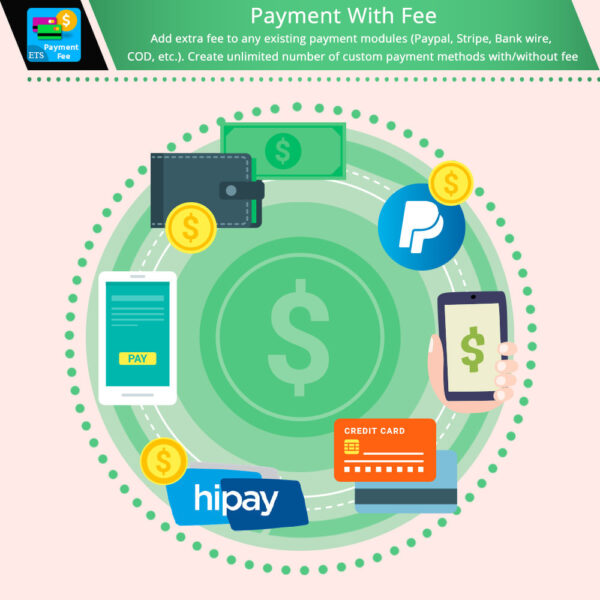Payment With Fee: PayPal, COD & custom payment methods Nulled is a feature or plugin often integrated into eCommerce platforms or business websites, allowing merchants to add additional fees based on payment methods. Whether you’re using PayPal, credit cards, or other payment gateways, certain fees are typically associated with processing those transactions. Payment With Fee enables business owners to pass on those fees to customers, ensuring that the merchant doesn’t absorb the extra cost, which can add up over time.
In this blog post, we’ll explore the features of Payment With Fee, discuss who it’s ideal for, evaluate its pros and cons, and compare it with popular alternatives that help manage payment processing costs.
1. Flexible Fee Structures
Payment With Fee: PayPal, COD & custom payment methods Free Download allows businesses to create flexible fee structures based on the payment method chosen by the customer. Different payment gateways, such as PayPal, Stripe, or bank transfers, can have varying transaction fees, and this feature lets merchants customize fees for each option. For example, you may choose to apply a higher fee for credit card payments compared to bank transfers or debit cards, reflecting the cost differences of each method.
This flexibility is essential for businesses that operate in regions with varying transaction costs or that use multiple payment gateways. The ability to adjust fees accordingly ensures that businesses aren’t forced to absorb high processing costs, which can eat into profit margins.
2. Seamless Integration with Popular eCommerce Platforms
Payment With Fee integrates seamlessly with popular eCommerce platforms like WooCommerce, Shopify, and Magento. These platforms support a wide range of payment gateways, and the plugin allows merchants to automate the process of adding fees based on the chosen gateway during the checkout process. Customers can see the fee breakdown before completing the payment, ensuring transparency.
The integration with WooCommerce, in particular, makes this feature attractive for WordPress users. It works well with WooCommerce’s payment gateways, including PayPal, Stripe, and more, allowing for a frictionless customer experience.
3. Customizable Fee Displays
Payment With Fee also provides the option to display the fees in various ways during the checkout process. Businesses can choose whether to show the fee as a separate line item, include it within the total cost, or add it as a percentage of the overall order. This level of customization enhances the user experience and ensures that customers clearly understand the additional charges associated with their chosen payment method.
In some cases, businesses may offer the ability to waive fees for specific payment options as an incentive to choose lower-cost methods, such as direct bank transfers. The customization feature enables businesses to configure these options based on their preferences.
Benefits for Businesses
1. Protection Against Profit Erosion
One of the key benefits of using Payment With Fee is the protection it offers businesses from profit erosion due to high transaction costs. Processing fees for credit cards or third-party payment gateways can vary from 1.5% to 3% or more, which can become a significant expense for businesses, particularly those with high transaction volumes. By passing these fees onto the customer, businesses can protect their profit margins.
2. Improved Cash Flow
When businesses implement Payment With Fee, it can help improve cash flow by ensuring that the full sale amount is collected without being reduced by processing fees. This is especially important for small businesses or startups that need to maximize their revenue. Every transaction processed without absorbing fees means more money is retained in the business, which can be used for growth, inventory, or other expenses.
3. Incentive for Low-Cost Payment Methods
Some businesses use Payment With Fee not just to cover processing costs but also as a strategic tool to encourage customers to use lower-cost payment methods. By applying fees to higher-cost options, such as credit cards, and waiving or minimizing fees for methods like bank transfers or debit cards, businesses can reduce their overall transaction fees.
This incentivization can help reduce the reliance on costly payment gateways, further optimizing profit margins for the business.
Who is Payment With Fee Ideal For?
- Small and Medium-Sized Businesses (SMBs): For businesses with tight margins, particularly SMBs, absorbing transaction fees can significantly impact the bottom line. Payment With Fee provides an easy way to pass those fees onto customers, ensuring that the business can operate profitably without cutting into revenue with high processing costs.
- ECommerce Stores with High Transaction Volumes: For eCommerce businesses that process a large number of transactions daily, transaction fees can add up quickly. Payment With Fee helps these businesses avoid absorbing the cost of these fees, preserving profit margins, and offering transparency to customers.
- Freelancers and Service Providers: Freelancers who charge clients through online payment gateways can use Payment With Fee to cover the cost of transaction fees. This ensures that the amount quoted to clients remains intact, even after the payment processor takes its cut.
- Subscription-Based Businesses: Subscription businesses, especially those that handle recurring payments, can benefit from implementing Payment With Fee. By ensuring that transaction fees are passed on to the customer, these businesses can stabilize revenue without worrying about cumulative losses over time.
Pros and Cons of Payment With Fee
Pros:
- Improves Profit Margins: By passing transaction fees onto customers, businesses can protect their profit margins, especially when dealing with high-cost payment methods.
- Flexible Fee Structures: Payment With Fee allows businesses to create custom fee structures based on payment methods, enabling them to adjust fees according to transaction costs.
- Transparency with Customers: The feature ensures transparency by clearly displaying fees during the checkout process, allowing customers to make informed decisions.
- Incentivizes Low-Cost Payment Options: Businesses can use fees strategically to encourage customers to choose payment methods with lower processing costs, helping further reduce overall transaction fees.
Cons:
- Potential Customer Frustration: Some customers may be discouraged by additional fees and could abandon their purchase at checkout, especially if they feel the fees are too high.
- Complexity for Beginners: While the feature integrates well with platforms like WooCommerce, setting up the fee structures and customizing the display can be challenging for users without experience in managing eCommerce platforms.
- May Not Be Allowed in All Regions: In certain countries or states, passing on transaction fees to customers may be restricted or subject to legal regulations. Businesses need to ensure they are compliant with local laws before implementing Payment With Fee Free Download.
Comparing Payment With Fee with Popular Alternatives
- WooCommerce Checkout Fees
- WooCommerce Checkout Fees is a popular plugin for WordPress users that allows you to add additional fees during checkout. While it offers similar functionality to Payment With Fee, WooCommerce Checkout Fees lacks the level of customization and flexibility that Payment With Fee provides, particularly when it comes to structuring fees based on specific payment gateways.
- Stripe Fees Plugin
- The Stripe Fees Plugin is designed specifically for businesses using Stripe as their payment processor. While it’s a great option for Stripe users, it lacks versatility when managing fees for multiple payment gateways, something Payment With Fee handles with ease.
- YITH WooCommerce Added to Cart Fee
- This plugin allows businesses to add fees based on product types or cart totals, but it’s not specifically designed for managing payment gateway fees. While useful in certain scenarios, it doesn’t offer the payment method-specific fee structures that Payment With Fee provides.
- CartFlows Checkout Fee
- CartFlows Checkout Fee allows for additional charges at the checkout stage based on cart totals or custom conditions. However, like YITH’s plugin, it doesn’t focus on transaction fees from different payment methods, limiting its usefulness for businesses looking to manage payment processing costs directly.
Payment With Fee Nulled is a valuable tool for businesses looking to manage the costs associated with payment processing. By passing fees onto customers, it allows businesses to protect their profit margins, improve cash flow, and provide transparency in the payment process. Ideal for small businesses, eCommerce stores, freelancers, and subscription-based services, this feature offers flexibility in structuring fees based on payment methods.
Changelog --------------------------------------- Version 2.4.7 - 8/8/2024 PrestaShop compatibility: 1.7.0.0 - 8.2.0 Module improvement Version 2.4.6 - 4/25/2024 PrestaShop compatibility: 1.7.0.0 - 8.2.0 Update translation for all supported languages Version 2.4.5 - 1/19/2024 PrestaShop compatibility: 1.7.0.0 - 8.2.0


![(v1.1.3 ) Sitemap Generator for SEO (XML & HTML) Nulled Module [PrestaShop]](https://nullgrand.com/wp-content/uploads/2024/11/Sitemap-Generator-for-SEO-XML-HTML-Module-v1.1.3-PrestaShop-218x150.webp)

![JPresta (v10.0.4) Speed Pack (Page Cache Ultimate + Lazy Loading + WEBP) Nulled [v1.7-v8x]](https://nullgrand.com/wp-content/uploads/2024/09/JPresta-Speed-Pack-PrestaShop-Nulled-218x150.webp)
![[v8] Google PageSpeed Insight (v8.1.4) Nulled Page Speed Optimization Module [Prestashop]](https://nullgrand.com/wp-content/uploads/2024/09/google-pagespeed-insight-webp-speed-optimization-600x600-1-218x150.jpg)
![(v5.4.03) Amazon Market Place Module Nulled [Prestashop v8x]](https://nullgrand.com/wp-content/uploads/2024/09/Amazon-Market-Place-Nulled-PrestaShop-Free-Download-218x150.webp)





